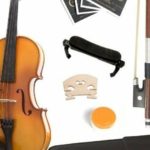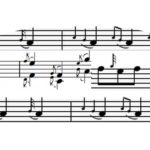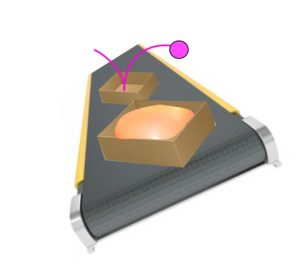The article below is from Ed Pearlman’s music columns in Scottish Life magazine. If you’re interested in a published collection of nearly 100 columns such as this one, please sign up here for info!
 My first experience of Gaelic singing in Scotland was magical and unexpected.
My first experience of Gaelic singing in Scotland was magical and unexpected.
It was nearly 11:00pm. The sun was setting over the striking landscape and glistening waters at the Kyle of Lochalsh. Brimming with a day of gorgeous Highland glens and castles, my wife and I impulsively decided to drive onto the ferry to Skye, and take our chances finding a place to stay.
Across the sea to Skye we rode, and stopped at the first payphone with our list of B&Bs. Alas–not a coin in our pockets!
Nearby was an inn. I walked in to ask for change–and immediately was drawn down the hallway by music like a siren’s call. A Gaelic singer and a local fiddler were giving a slide show of the Western Isles. The singer was Catherine-Anne MacPhee of Barra, one of Scotland’s finest Gaelic singers.
A year later, Catherine-Anne made the first of her three beautiful recordings of Gaelic singing, backed by some of Scotland’s finest musicians from the great bands Ossian, Capercaillie, and Easy Club. In her latest album she sings the title role on the soundtrack of Mairi Mhor, a TV production about a Gaelic woman ousted from her native Skye in the 19th century. Mairi Mhor began writing her own songs at age 50, and her first song begins,
I am weary of the speakers of English
I long for some warmth and music
The warmth and music of Gaelic singing is accessible to us all. It took hold of me that lucky night on Skye. Never mind that I don’t speak a word of Gaelic. Gaelic singing is some of the most enjoyable listening you could hope for–sweet, lilting music punctuated by powerful rhythms and haunting melodies.
It is one of the wellsprings of Scottish music. Many songs of Robert Burns, and tunes played on fiddle, pipes and harp, derive from Gaelic songs. Even some tunes and gospel songs found in the U.S. can be traced through Scottish immigrants to old Gaelic melodies. It is said that Dvorak’s theme in the New World Symphony was inspired by the Gaelic song, McIntosh’s Lament, as heard in this country.
No matter how strong the beat, or how plaintive the song, I find there is an effortless flow in the music and words of the Gaelic song. The descriptive songs can be sparkling and light, the love songs or laments may be dark and haunting–sometimes with breathtaking twists in the melody. The songs for working the cloth (waulking songs) have a strong rhythm, while the “mouth music” (puirt-a-beul) pulses with a dance beat. Yet overall, listening to an album of Gaelic singing is a quieting experience.
One of my favorite albums of Gaelic songs is called Mairidh Gaol Is Ceol, by the “supergroup” Mac-Talla. This group includes three of the finest contemporary singers of the Western Isles: Arthur Cormack of Skye, and Christine Primrose and Eilidh MacKenzie, both of Lewis. Their soaring harmonies and heartfelt singing are captivating, with instrumental accompaniment on harp, cello and keyboards. Each of these singers also has at least one solo album, backed by musicians from the Battlefield Band.
While some seek to preserve traditions, others incorporate them into their own artistry. The result is often striking and creative. Runrig is a Gaelic band with a rock beat. Capercaillie, which appeared in Rob Roy, offers beautiful Gaelic singing mixed with English-language songs and instrumentals. The Rankin Family of Cape Breton offers Gaelic songs with rich harmonies, and solo singers such as Mairi MacInnes make Gaelic a major part of their popular repertoire.
But the older traditional recordings have an unmatched heart and soul despite the rough edges of untrained singers. The School of Scottish Studies offers a series of traditional albums available on Greentrax Records, including Music from the Western Isles, Waulking Songs from Barra, and Gaelic Psalms from Lewis.
Temple Records presents traditional but more polished singers such as Flora MacNeil of Barra, who helped revive Gaelic singing in Scotland after the war, and scholar, piper and singer Finlay MacNeill from Lewis.
Listen also to Maeve MacKinnon of Skye, or the Glasgow Gaelic Music Association’s choral music. There is no better way to appreciate Gaelic singing than to listen to it. Don’t miss out on one of Scotland’s musical treasures.
By the way, we did find a B&B on Skye after 11pm, but do you think it was easy to tear myself away from the singing of Cathy-Anne MacPhee, just to make a few phone calls?
©1996 Edward Scott Pearlman
Although this column was written in 1996, the recordings referenced are timeless. Many more recordings have been made available since then as well! Enjoy.
 A long time ago on an island far, far away, a new Celtic music festival was born. It was the summer of 1996, on the Isle of Lewis in the Outer Hebrides.
A long time ago on an island far, far away, a new Celtic music festival was born. It was the summer of 1996, on the Isle of Lewis in the Outer Hebrides.




